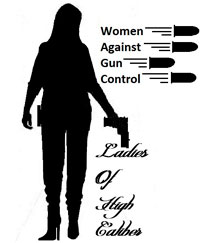The Sexism of Gun Control
Carrie (in La.), what would you, as a lady in that postion, say to the anti self defense folks here who claim (and I quote)”Maybe if you’re a big, white guy who hunts all the time, it might do some good,” Haymaker said, referring to the governor’s recent endorsement for women to arm themselves. “For a woman who is surprise attacked, having a gun is only giving them (the attacker) another way to kill you.”
+++++++++++++++++++
FYI (copy below, reference links in original):
http://www.ifeminists.com/introduction/editorials/2002/0813b.html>
=======================================================
The Sexism of Gun Control
August 13, 2002
by David Graham
Last week, Louisiana Governor Mike Foster reminded women in
his state that they have a right to buy a handgun for
personal protection. He said this because a serial killer
is currently loose in Baton Rouge, and women are scared to
death. In response to Foster’s advice, the anti-gun crowd
has been making their usual hackneyed prediction that blood
will run in the streets if a large number of ordinary people
buy guns for self-defense. What’s unusual about the current
response is the barely veiled sexism behind their warnings.
An article in the Advocate Online quotes Holley Galland
Haymaker from the anti-gun group Louisiana Ceasefire as
follows:
“Maybe if you’re a big, white guy who hunts all the time, it
might do some good,” Haymaker said, referring to the
governor’s recent endorsement for women to arm themselves.
“For a woman who is surprise attacked, having a gun is only
giving them (the attacker) another way to kill you.”
There are so many disturbing assumptions built into this
statement that it’s hard to know where to begin. Let’s
start with the “big, white guy” phrase. What could Haymaker
mean by that? Is he saying that only men can be trusted to
use guns safely and effectively? And what does being “big”
have to do with anything? If you have a gun, what
difference does it make what size you are? One of the
reasons women need a gun is that they tend to be smaller and
weaker than male attackers, and the gun levels this
disparity of power. Maybe Haymaker thinks if you’re a small
woman, you’re too weak and clumsy to handle a gun. Even
more jarring is how Haymaker specifically mentions a “white”
guy. Does he think people of color, particularly women of
color, are too inept and stupid to learn how to use a
handgun or rifle? While Haymaker says that a gun “might do
some good” for a big, white, male hunter who is attacked by
a serial killer, a woman, he implies, will only lose control
of the gun and get herself killed. Can we attribute this
thinking to anything but sexism?
I don’t know if Haymaker has personal experience with guns,
but his remark suggests complete ignorance of how guns work
and the purpose of various types of gun training. With the
exception of “big game” hunters who go after elephants with
.44 magnum revolvers, the average person who “hunts all the
time” would necessarily be familiar with the use of rifles,
not handguns. The skills needed for hunting animals with a
rifle are different from the skills needed to defend
yourself with a handgun. A hunter lies in wait and
surprises an animal, such as a deer, who is not trying to
harm him. He has to make accurate shots up to 200 yards
away, usually with the aid of a scope mounted on his rifle.
A person using a handgun for self defense, on the other
hand, needs a different kind of training. She needs to know
the law. When is it legal to shoot an attacker? She needs
to know how to quickly acquire “sight picture” (that is,
aim) and fire shots at an attacker’s chest before he can get
to her. If she is carrying a concealed weapon, she needs to
practice brisk “presentation” (or draw) of her handgun.
And, in case her attacker has a gun, she has to know how to
shoot from behind cover and concealment–such as a dresser,
bed, or vehicle. Her range of shooting is likely to be
around seven yards, not 200 yards.
Given these differences, the mere fact that a man hunts with
a rifle is no guarantee that he would be better than a woman
at handgunning. In fact, some experts think that, all
things being equal, a novice woman is more likely to excel
at defensive handgunning than a novice man. Any firearms
instructor will tell you that women tend to make the best
students. The usual explanation is that women, unlike men,
don’t have big egos when it comes to firearms. Men tend to
be less receptive to correction. “I know about guns,” they
think, “and I really don’t need this guy telling me how to
grip my gun and aim at a target.” Women tend to be more
honest about their lack of skill. After all, our society
doesn’t expect women to know anything about guns, so there
is less pressure on her ego. This makes her more likely to
listen carefully to the instructor and take his advice to
heart.
Haymaker is not alone in making sexist implications in the
wake of Governor Foster’s advice. On a recent episode of
Hardball, an anti-gun lawyer (whose name I do not remember)
debated Paxton Quigley, the pro-gun advocate who has trained
thousands of woman to use guns for self-defense. The lawyer
said he knew of a couple of incidents in which women mistook
their husbands for attackers and shot them. It seems that
in each case, the husband had been out drinking all night
while his wife slept at home. Hearing someone stagger into
the apartment, the wife grabbed for her handgun and shot the
shadowy figure, who turned out to be her husband. The first
thing to notice is that the lawyer deliberately chose
examples in which a woman shot someone by accident. Why
didn’t he cite a mistaken shooting by a man, such as one of
the all-too-common hunting accidents that we hear about?
Why didn’t he simply cite the total number of
mistaken-identity shootings each year? Because he clearly
wants to imply that women are more likely to use stupid
judgment, and therefore Governor Foster was reckless to tell
women they could be trusted with guns. The second thing to
notice is the sheer irrelevance of the accidental shootings
cited by the lawyer (assuming these incredible cases really
happened). Just because a couple of people did something
stupid does not mean that the majority of smart and
responsible people should not keep a gun for self-defense.
Every year a number of children drown in swimming pools
because their parents were not watching them. Do we
conclude that no parents should have a pool in their
backyard? Besides, even if we accept the utilitarian,
non-rights premise of gun-control advocates, the number of
people who defend themselves with a gun–somewhere between
80,000 and 2,000,000 each year–vastly outnumbers the number
of accidental deaths involving guns.
Readers who are familiar with the history of defensive
handgunning in America will notice a similarity between the
present situation in Louisiana and a situation in Florida
over thirty years ago. After a series of brutal rapes in
Orlando in 1966, hundreds of women began buying handguns
each week to protect themselves. When the anti-gun Orlando
Sentinel Star found out, it ran editorials denouncing the
trend. Its publisher, apparently sharing the view of
today’s anti-gun advocates that women are too weak and inept
to have guns, even went to the chief of police demanding
that he stop the sale of handguns to women. That was
impossible, of course. But as an alternative, the chief and
the newspaper publisher came up with an alternative: If
they could not stop women from buying handguns, at least
they could co-sponsor a training program so that all these
women would know how to use their new handguns properly.
The newspaper advertised the course, and in five months more
than 6000 women had been trained.
What happened next? Although the yearly number of rapes had
been increasing before the classes, reaching 36 in 1966, it
fell to only four in 1967. Meanwhile the rape rates for the
surrounding metropolitan area, Florida, and the entire
nation continued to rise. Although a correlation between
two events A and B does not necessarily prove a causal
relationship, it is quite possible–and in line with highly
controlled studies by researchers like John Lott–that all
the publicity about women buying guns scared rapists so
badly that many of them stopped preying on women for fear of
being shot dead in the act. More important, there was no
rash of accidental shootings by women in Orlando. Women
were not seized by fits of irrational, panic-fueled violence
in the pre-dawn hours, causing them to blow away the
paperboy or their late-returning husbands.
If the women of Baton Rouge, Louisiana, are independent
enough to think for themselves–if they turn a critical eye
on the lies, fallacies, and limp self-defense tips of the
anti-gun crowd–perhaps they will have a deterrent effect on
crime in their area, much like the women of Orlando in 1966.
With proper training, they can also enjoy the peace of mind
that comes from having the best means possible for defending
their bodies and their lives from brutal attackers. They
might as well face the hard fact that police cannot protect
them, no more than they protected Pam Kinamore, whose throat
was slit by the serial killer now loose in Louisiana, or
Charlotte Murray Pace, who, according to DNA evidence, was
stabbed to death by the same killer. It’s up to women to
defend themselves.



